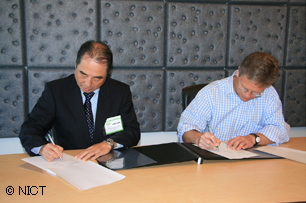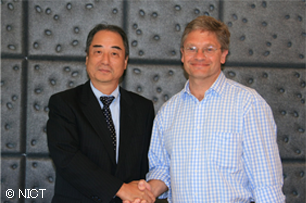National Institute of Information and Communications Technology (NICT, President: Dr. Hideo Miyahara) and National ICT Australia Ltd. (NICTA, Chief Executive Officer: Dr. Hugh Durrant-Whyte) signed a Memorandum of Understanding (MOU) on international cooperation at the head office of NICTA on September 26, 2011. Already, researchers of NICT and NICTA were in contact for a long time in the fields of New Generation Network and Body Area Network at various international conferences and standardization meetings. By exchanging the MOU, both organizations will further promote collaborative projects and are wishing to expand cooperation fields.
Home > Press Release > Memorandum of Understanding was signed with NICTA


Left : Dr. Kazumasa Enami (Vice President of NICT), Right : Dr. Hugh Durrant-Whyte (CEO of NICTA)
Supplementary Information
NICTA (National ICT Australia Ltd) is Australia’s Information and Communications Technology Research Centre of Excellence. NICTA’s primary goal is to build and deliver excellence in ICT research and commercial outcomes for Australia. URL : http://www.nicta.com.au/
The future holds a computing environment characterized by embedded and pervasive computing and networking that will benefit society worldwide, not just the current state in which computers and networks are proliferating widely. The current Internet, which was not designed with this kind of pervasive information-networked society in mind, cannot handle this societal transition, leaving it unable to further mankind's potential. To realize this kind of information-networked society envisioned for the next two or three decades, a new generation network must be created before the current Internet reaches its limits.
A Body Area Network (BAN) is a wireless network that comprises small devices placed on surface of, inside of, or in the vicinity of a human body and connected by wireless communication. Incorporating sensors for body temperature, electrocardiogram, carotid pulse, and a triaxial accelerometer in the BAN allows us to monitor the health status and activities of a person in real time, which helps to prevent chronic diseases, provides close monitoring of elderly, and removes some of the burden from those who provide nursing services on a daily basis.
Contact regarding the MOU
International Relations Office
International Affairs Department
Tel: +81-42-327-7557
E-mail: 
















Media Contact
Public Relations Department
Tel: +81-42-327-6923
E-mail: 

























